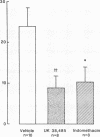Abstract
Some studies have indicated that PGs can modulate the single nephron tubuloglomerular feedback (TGF) response. The aim of this study was to define the specific role of the vasoconstrictor PG, TX, by administration to rats of either vehicle (group 1; n = 20) or drugs that inhibit either cyclooxygenase (indomethacin [indo], 5 mg.kg-1, group 2, n = 17), TX synthetase (UK-38,485 [UK], 100 mg.kg-1, group 3, n = 19), or TX receptors (SQ-29,548 [SQ], 8 mg.kg-1, group 4, n = 14, or L-641,953 [L], 50 mg.kg-1, group 5, n = 8). Indo reduced excretion of the prostacyclin derivative 6-keto-PGF1 alpha and TXB2 and lowered whole kidney GFR and renal plasma flow, whereas UK lowered excretion of TXB2 only and did not change basal renal hemodynamics. The TGF response (assessed from reduction in proximal tubule stop-flow pressure (Psf, mmHg) during increases in perfusion of the loop of Henle (LH) from 0 to 40 nl.min-1) was unchanged after vehicle (9.8 +/- 0.5-10.9 +/- 1.0, NS) but blunted (P less than 0.001) by 40-65% in rats of groups 2-5 (indo, 11.1 +/- 1.0-4.4 +/- 0.7; UK, 9.0 +/- 0.8-4.8 +/- 0.7; SQ, 10.3 +/- 0.6-4.8 +/- 0.6; L, 10.7 +/- 0.5-6.7 +/- 1.3). This blunting was due to lower values for Psf at zero LH flow after indo, SQ, and L, and higher values of Psf at 40 nl.min-1 LH flow after indo and UK. The fall in single nephron GFR (SNGFR, nl.min-1) with increasing LH perfusion was unchanged after vehicle (10.9 +/- 2.8-11.2 +/- 0.8) but was blunted (P less than 0.05) by 45-55% in rats given indo (13.9 +/- 1.2-6.2 +/- 2.2) or UK (12.8 +/- 2.1-7.0 +/- 1.5). UK produced dose-dependent reductions in TXB2 excretion (IC50, 15 mg.kg-1) and inhibition of the TGF response (IC50: 30 mg.kg-1). After blockade of TX receptors by SQ, UK had no further affect on the TGF response. The fall in Psf at high LH flow was blunted (P less than 0.05) by indo and UK, whereas the rise in Psf at zero LH flow was blunted by indo, SQ, and L. In conclusion, endogenous TX generation can modulate the reductions in Psf and SNGFR during increased delivery of NaCl to the LH.
Full text
PDF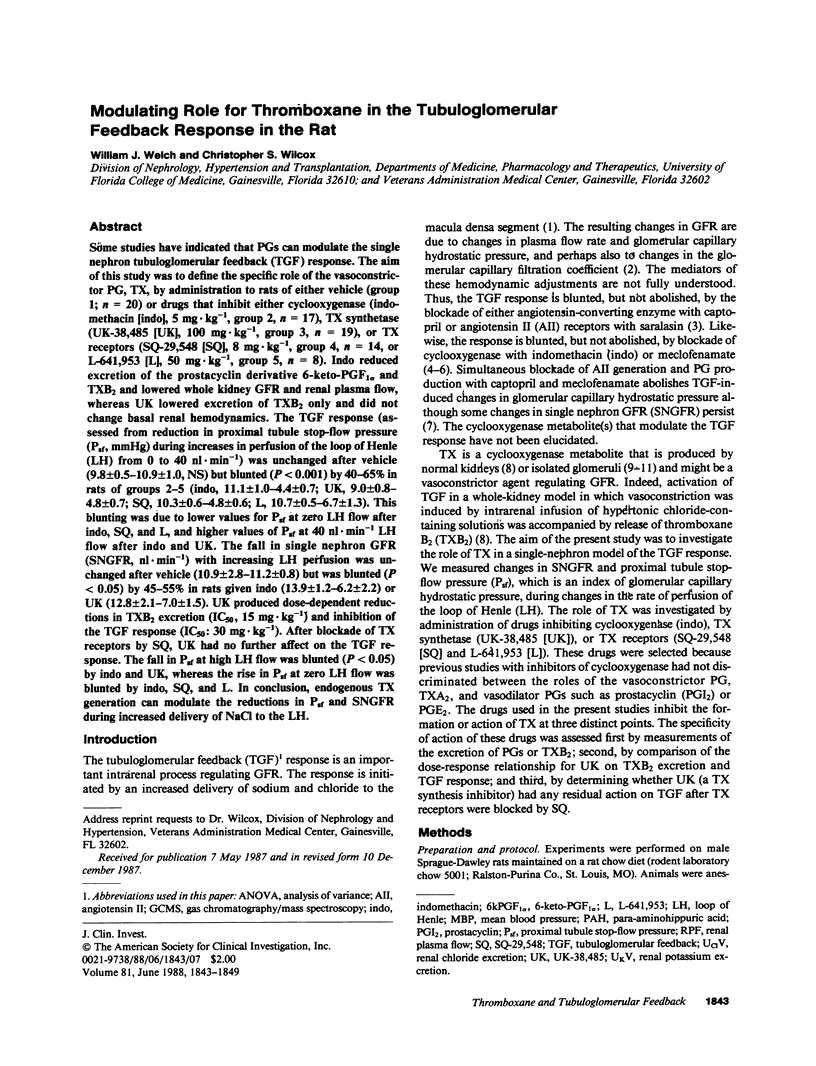
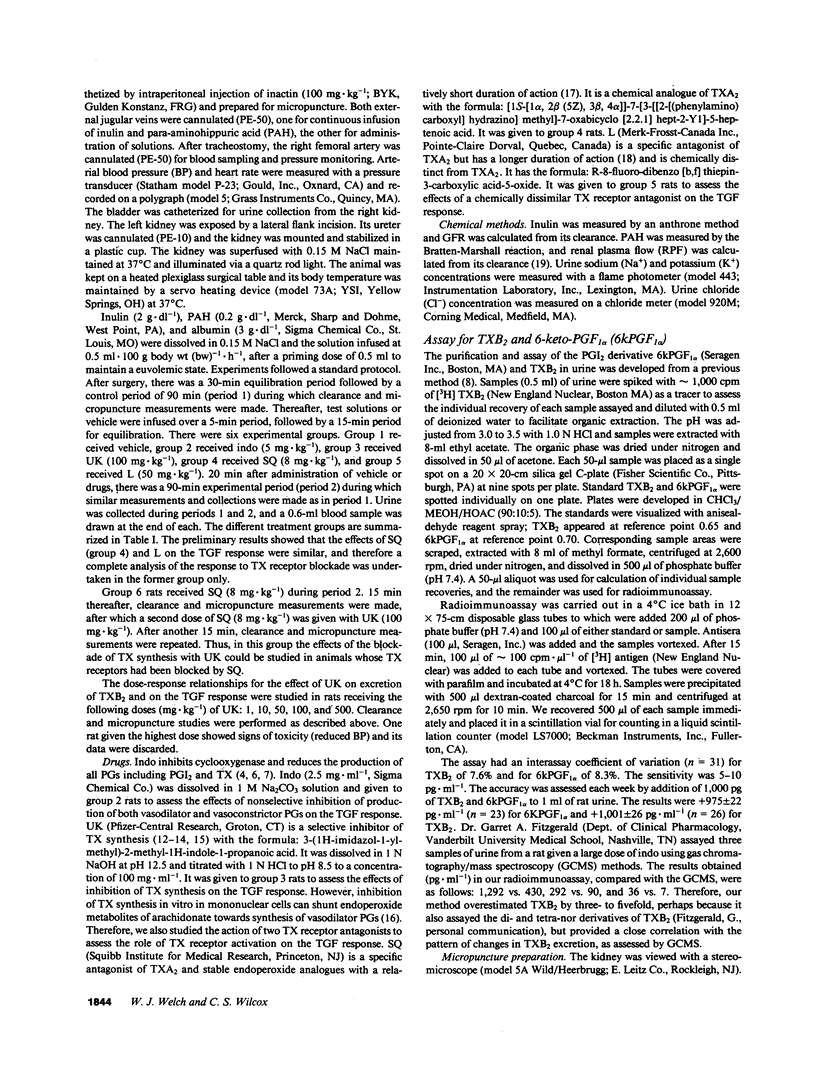
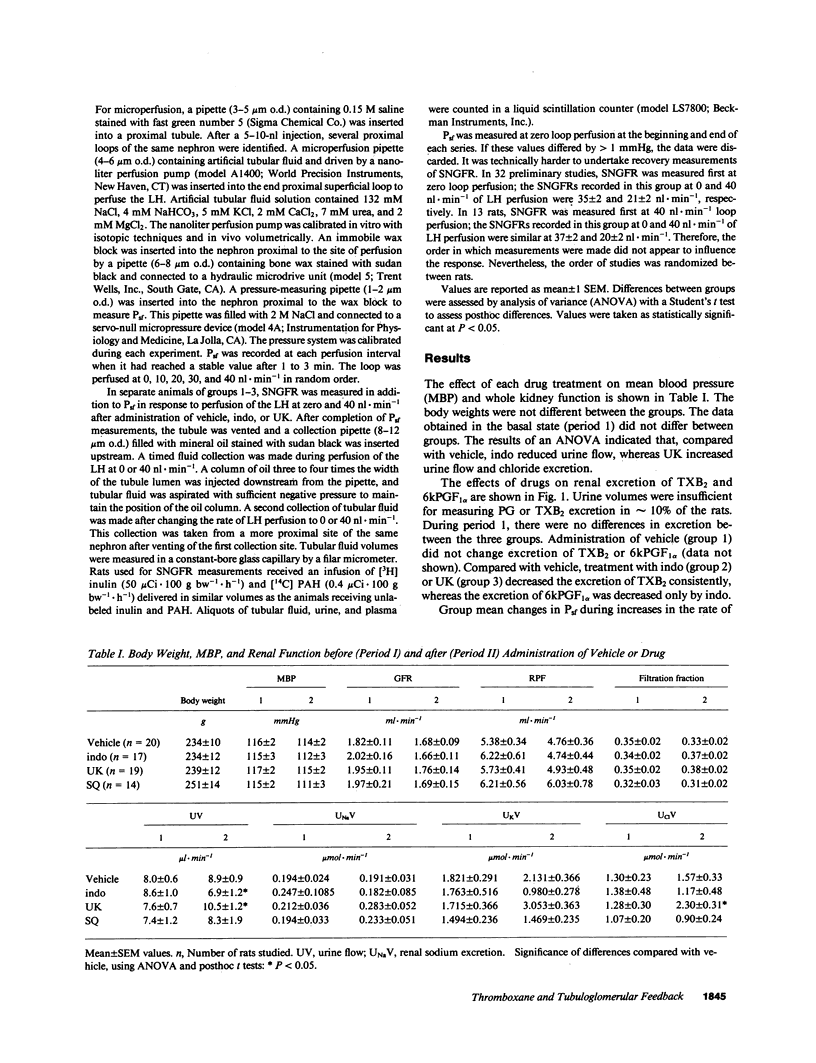

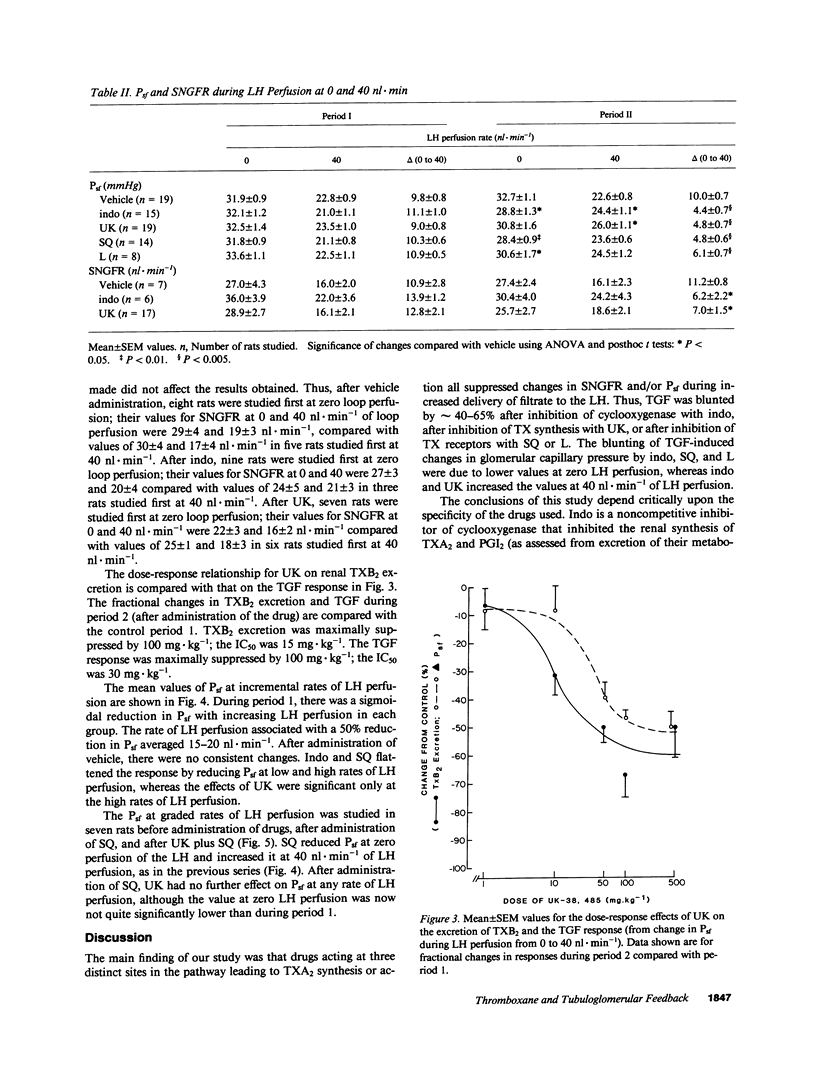
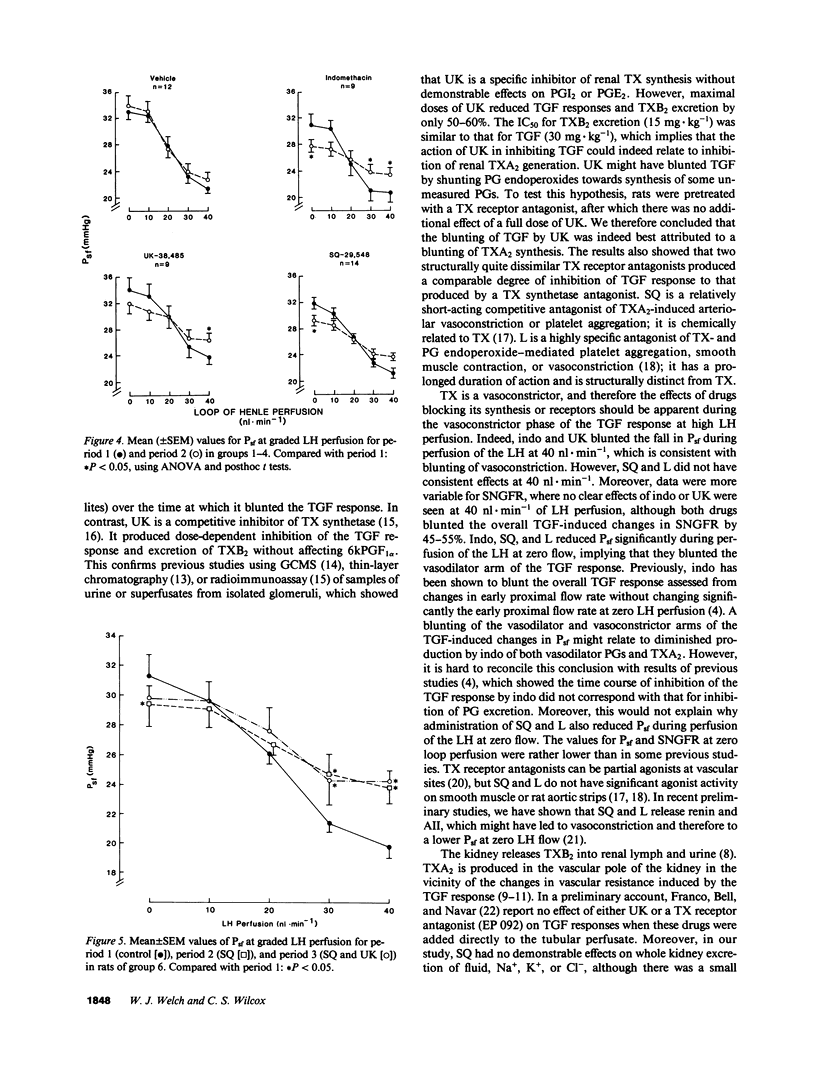
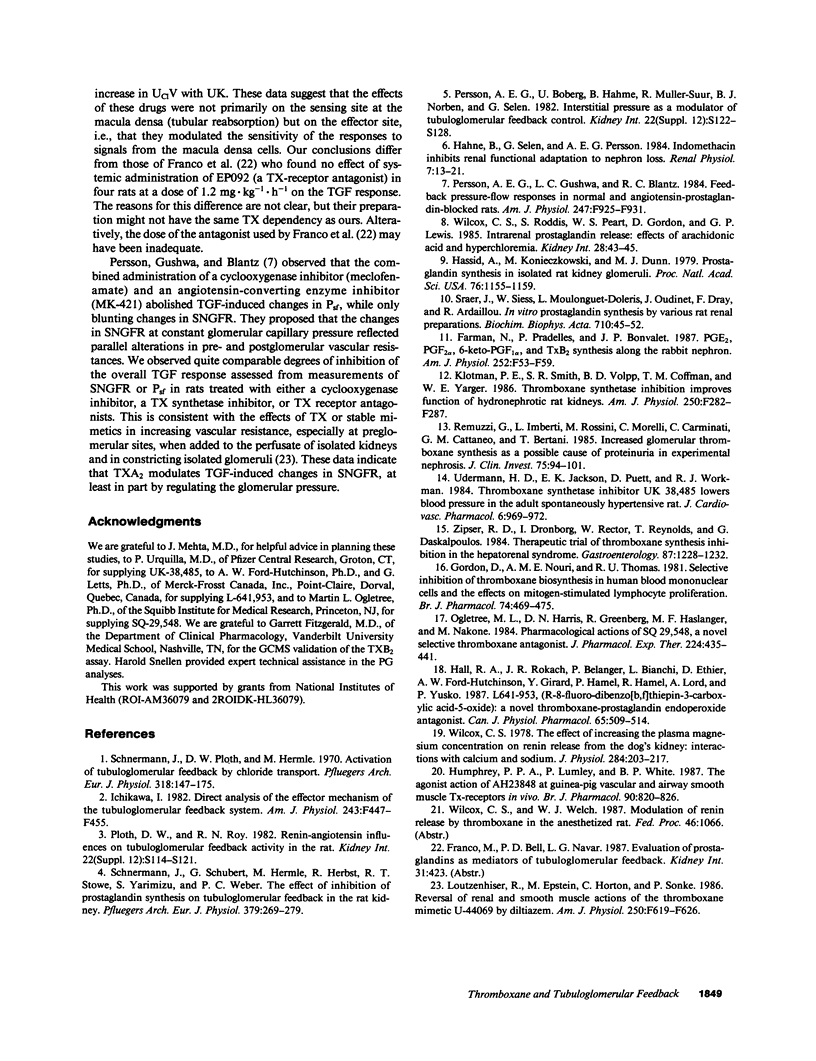
Images in this article
Selected References
These references are in PubMed. This may not be the complete list of references from this article.
- Farman N., Pradelles P., Bonvalet J. P. PGE2, PGF2 alpha, 6-keto-PGF1 alpha, and TxB2 synthesis along the rabbit nephron. Am J Physiol. 1987 Jan;252(1 Pt 2):F53–F59. doi: 10.1152/ajprenal.1987.252.1.F53. [DOI] [PubMed] [Google Scholar]
- Gordon D., Nouri A. M., Thomas R. U. Selective inhibition of thromboxane biosynthesis in human blood mononuclear cells and the effects of mitogen-stimulated lymphocyte proliferation. Br J Pharmacol. 1981 Oct;74(2):469–475. doi: 10.1111/j.1476-5381.1981.tb09992.x. [DOI] [PMC free article] [PubMed] [Google Scholar]
- Hahne B., Selén G., Erik A., Persson G. Indomethacin inhibits renal functional adaptation to nephron loss. Ren Physiol. 1984;7(1):13–21. doi: 10.1159/000172920. [DOI] [PubMed] [Google Scholar]
- Hall R. A., Rokach J. R., Bélanger P., Bianchi L., Ethier D., Ford-Hutchinson A. W., Girard Y., Hamel P., Hamel R., Lord A. L-641,953 (R-8-fluoro-dibenzo[b, f]thiepin-3-carboxylic acid-5-oxide): a novel thromboxane-prostaglandin endoperoxide antagonist. Can J Physiol Pharmacol. 1987 Apr;65(4):509–514. doi: 10.1139/y87-087. [DOI] [PubMed] [Google Scholar]
- Hassid A., Konieczkowski M., Dunn M. J. Prostaglandin synthesis in isolated rat kidney glomeruli. Proc Natl Acad Sci U S A. 1979 Mar;76(3):1155–1159. doi: 10.1073/pnas.76.3.1155. [DOI] [PMC free article] [PubMed] [Google Scholar]
- Ichikawa I. Direct analysis of the effector mechanism of the tubuloglomerular feedback system. Am J Physiol. 1982 Nov;243(5):F447–F455. doi: 10.1152/ajprenal.1982.243.5.F447. [DOI] [PubMed] [Google Scholar]
- Klotman P. E., Smith S. R., Volpp B. D., Coffman T. M., Yarger W. E. Thromboxane synthetase inhibition improves function of hydronephrotic rat kidneys. Am J Physiol. 1986 Feb;250(2 Pt 2):F282–F287. doi: 10.1152/ajprenal.1986.250.2.F282. [DOI] [PubMed] [Google Scholar]
- Loutzenhiser R., Epstein M., Horton C., Sonke P. Reversal of renal and smooth muscle actions of the thromboxane mimetic U-44069 by diltiazem. Am J Physiol. 1986 Apr;250(4 Pt 2):F619–F626. doi: 10.1152/ajprenal.1986.250.4.F619. [DOI] [PubMed] [Google Scholar]
- Persson A. E., Boberg U., Hahne B., Müller-Suur R., Norlén B. J., Selén G. Interstitial pressure as a modulator of tubuloglomerular feedback control. Kidney Int Suppl. 1982 Aug;12:S122–S128. [PubMed] [Google Scholar]
- Persson A. E., Gushwa L. C., Blantz R. C. Feedback pressure-flow responses in normal and angiotensin-prostaglandin-blocked rats. Am J Physiol. 1984 Dec;247(6 Pt 2):F925–F931. doi: 10.1152/ajprenal.1984.247.6.F925. [DOI] [PubMed] [Google Scholar]
- Ploth D. W., Roy R. N. Renin-angiotensin influences on tubuloglomerular feedback activity in the rat. Kidney Int Suppl. 1982 Aug;12:S114–S121. [PubMed] [Google Scholar]
- Remuzzi G., Imberti L., Rossini M., Morelli C., Carminati C., Cattaneo G. M., Bertani T. Increased glomerular thromboxane synthesis as a possible cause of proteinuria in experimental nephrosis. J Clin Invest. 1985 Jan;75(1):94–101. doi: 10.1172/JCI111703. [DOI] [PMC free article] [PubMed] [Google Scholar]
- Schnermann J., Schubert G., Hermle M., Herbst R., Stowe N. T., Yarimizu S., Weber P. C. The effect of inhibition of prostaglandin synthesis on tubuloglomerular feedback in the rat kidney. Pflugers Arch. 1979 Apr 30;379(3):269–279. doi: 10.1007/BF00581431. [DOI] [PubMed] [Google Scholar]
- Uderman H. D., Jackson E. K., Puett D., Workman R. J. Thromboxane synthetase inhibitor UK38,485 lowers blood pressure in the adult spontaneously hypertensive rat. J Cardiovasc Pharmacol. 1984 Sep-Oct;6(5):969–972. doi: 10.1097/00005344-198409000-00035. [DOI] [PubMed] [Google Scholar]
- Wilcox C. S., Roddis S., Peart W. S., Gordon D., Lewis G. P. Intrarenal prostaglandin release: effects of arachidonic acid and hyperchloremia. Kidney Int. 1985 Jul;28(1):43–50. doi: 10.1038/ki.1985.116. [DOI] [PubMed] [Google Scholar]
- Wilcox C. S. The effect of increasing the plasma magnesium concentration on renin release from the dog's kidney: interactions with calcium and sodium. J Physiol. 1978 Nov;284:203–217. doi: 10.1113/jphysiol.1978.sp012536. [DOI] [PMC free article] [PubMed] [Google Scholar]
- Zipser R. D., Kronborg I., Rector W., Reynolds T., Daskalopoulos G. Therapeutic trial of thromboxane synthesis inhibition in the hepatorenal syndrome. Gastroenterology. 1984 Dec;87(6):1228–1232. [PubMed] [Google Scholar]




